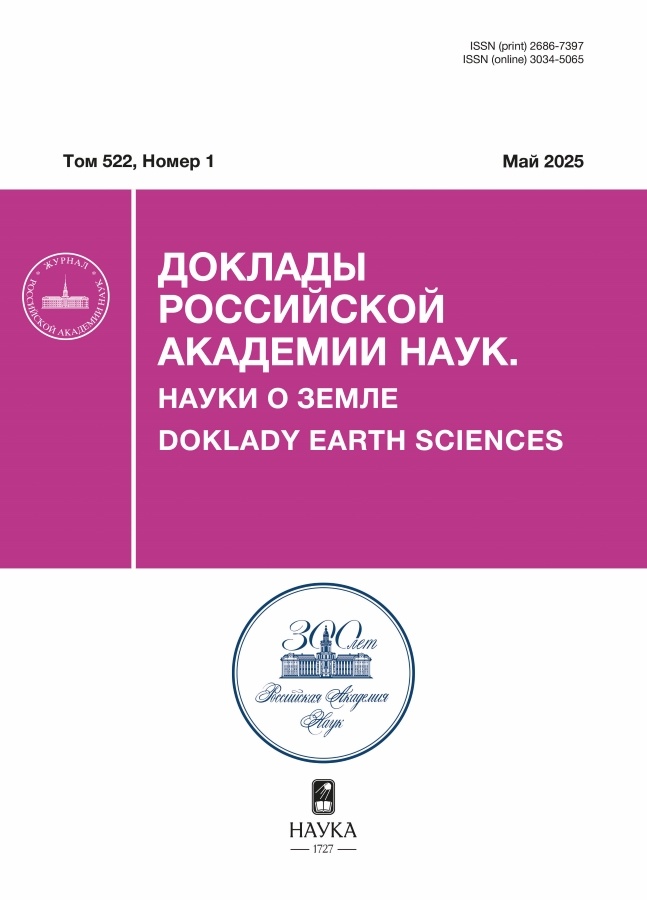The “Dusty Haze” Effect in the Atmosphere of a Megapolis
- 作者: Gubanova D.P.1, Ginzburg A.S.1, Vinogradova A.A.1, Chkhetiani O.G.1, Semenov V.A.1,2
-
隶属关系:
- A.M. Obukhov Institute of Atmospheric Physics, Russian Academy of Sciences
- Institute of Geography RAS
- 期: 卷 522, 编号 1 (2025)
- 页面: 164-172
- 栏目: GEOECOLOGY
- ##submission.dateSubmitted##: 15.10.2025
- ##submission.datePublished##: 15.12.2025
- URL: https://journals.eco-vector.com/2686-7397/article/view/693290
- DOI: https://doi.org/10.31857/S2686739725050202
- ID: 693290
如何引用文章
详细
作者简介
D. Gubanova
A.M. Obukhov Institute of Atmospheric Physics, Russian Academy of Sciences
Email: gubanova@ifaran.ru
Moscow, Russia
A. Ginzburg
A.M. Obukhov Institute of Atmospheric Physics, Russian Academy of Sciences
Email: gubanova@ifaran.ru
Moscow, Russia
A. Vinogradova
A.M. Obukhov Institute of Atmospheric Physics, Russian Academy of Sciences
Email: gubanova@ifaran.ru
Moscow, Russia
O. Chkhetiani
A.M. Obukhov Institute of Atmospheric Physics, Russian Academy of Sciences
Email: gubanova@ifaran.ru
Moscow, Russia
V. Semenov
A.M. Obukhov Institute of Atmospheric Physics, Russian Academy of Sciences; Institute of Geography RAS
Email: gubanova@ifaran.ru
Moscow, Russia; Moscow, Russia
参考
- Kok J.F., Storelvmo T., Karydis V.A. et al. Mineral dust aerosol impacts on global climate and climate change // Nat. Rev. Earth Environ. 2023. V. 4. P. 71–86. https://doi.org/10.1038/s43017-022-00379-5
- Гинзбург А.С., Губанова Д.П., Минашкин В.М. Влияние естественных и антропогенных аэрозолей на глобальный и региональный климат // Российский химический журнал. 2008. Т. 52. № 5. С. 112‒119.
- Mahowald N.M., Kloster S., Engelstaedter S. et al. Observed 20th century desert dust variability: impact on climate and biogeochemistry // Atmos. Chem. Phys. 2010. V. 10. P. 10875–10893. https://doi.org/10.5194/acp-10-10875-2010
- Zhang X., Zhao L., Tong D.Q. et al. Systematic Review of Global Desert Dust and Associated Human Health Effects // Atmosphere. 2016. V. 7. 158. https://doi.org/10.3390/atmos7120158
- Ginoux P., Prospero J.M., Gil T.E. et al. Global-scale attribution of anthropogenic and natural dust sources and their emission rates based on MODIS Deep Blue aerosol products // Rev. Geophys. 2012. V. 50. RG3005. https://doi.org/10.1029/2012RG000388
- Ivaneev A.I., Brzhezinskiy A.S., Karandashev V.K. et al. Assessment of sources, environmental, ecological, and health risks of potentially toxic elements in urban dust of Moscow megacity, Russia // Chemosphere. 2023. V. 321. 138142. https://doi.org/10.1016/j.chemosphere.2023.138142
- Shukurov K.A., Simonenkov D.V., Nevzorov A.V. et al. CALIOP-Based Evaluation of Dust Emissions and Long-Range Transport of the Dust from the Aral−Caspian Arid Region by 3D-Source Potential Impact (3D-SPI) Method // Remote Sens. 2023. V. 15. 2819. https://doi.org/10.3390/rs15112819
- Shukurov K.A., Chkhetiani O.G. Probability of transport of air parcels from the arid lands in the Southern Russia to Moscow region // Proc. SPIE. 2017. 10466. https://doi.org/10.1117/12.2287932
- Gubanova D., Chkhetiani O., Vinogradova A. et al. Atmospheric transport of dust aerosol from arid zones to the Moscow region during fall 2020 // AIMS Geosciences. 2022. V. 8. No 2. P. 277‒302. https://doi.org/10.3934/geosci.2022017
- Gubanova D.P., Vinogradova A.A., Kotova E.I. Long-Range Atmospheric Transport of dust from the Caspian Sea region to the Arctic zone of the European part of Russia in December 2023 // Doklady Earth Sciences. 2024. https://doi.org/10.1134/S1028334X24602852 (in print)
- Губанова Д.П., Виноградова А.А., Скороход А.И., Иорданский М.А. Аномальное аэрозольное загрязнение воздуха в Москве вблизи локального антропогенного источника в июле 2021 года // Гидрометеорологические исследования и прогнозы. 2021. № 4 (382). С. 134‒148. https://doi.org/10.37162/2618-9631-2021-4-134-148
- Seinfeld J.H., Pandis S.N. Atmospheric chemistry and physics: from air pollution to climate change, 2nd Еd. New York: Wiley, USA, 2006. 1232 p.
- Губанова Д.П., Виноградова А.А., Лезина Е.А. и др. Условно-фоновый уровень аэрозольного загрязнения приземного воздуха в Москве и пригороде: сезонные вариации // Изв. РАН. Физика атмосферы и океана. 2023. Т. 59. № 6. С. 754‒773. https://doi.org/10.31857/S0002351523060056
- Кузнецова И.Н., Шалыгина И.Ю., Нахаев М.И. и др. Неблагоприятные для качества воздуха метеорологические факторы // Труды Гидрометеорологического научно-исследовательского центра Российской Федерации. 2014. № 351. С. 154‒172.
- Popovicheva O., Diapouli E., Chichaeva M. et al. Aerosol characterization and peculiarities of source apportionment in Moscow, the largest and northernmost European megacity // Science of The Total Environment. 2024. V. 918. 170315. https://doi.org/10.1016/j.scitotenv.2024.170315
- Kasimov N., Chalov S., Chubarova N. et al. Urban heat and pollution island in the Moscow megacity: Urban environmental compartments and their interactions // Urban Climate. 2024. V. 55. 101972. https://doi.org/10.1016/j.uclim.2024.101972
- Губанова Д.П., Чхетиани О.Г., Кудерина Т.М. и др. Экспериментальные исследования аэрозолей в атмосфере семиаридных ландшафтов Калмыкии. 1. Микрофизические параметры и массовая концентрация аэрозольных частиц // Геофизические процессы и биосфера. 2018. Т. 17. № 1. С. 5‒29. https://doi.org/10.21455/GPB2018.1-1
- Chkhetiani O.G., Vazaeva N.V., Chernokulsky A.V. et al. Analysis of Mineral Aerosol in the Surface Layer over the Caspian Lowland Desert by the Data of 12 Summer Field Campaigns in 2002–2020. Atmosphere. 2021. Т. 12. № 8 // Atmosphere. 2021. V. 12. 985. https://doi.org/10.3390/atmos12080985
- Vlasov D., Kosheleva N., Kasimov N. Spatial distribution and sources of potentially toxic elements in road dust and its PM10 fraction of Moscow megacity // Science of The Total Environment. 2021. V. 761. 143267. https://doi.org/10.1016/j.scitotenv.2020.143267
- Ivaneev A., Brzhezinskiy A., Karandashev V. et al. Nanoparticles of dust as an emerging contaminant in urban environments // Environ Geochem Health. 2024. V. 46. 367. https://doi.org/10.1007/s10653-024-02139-4
补充文件









